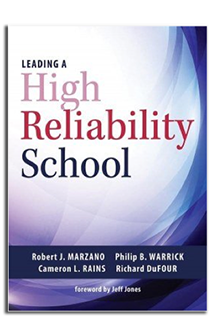
After an eventful 2018 as an incoming comprehensive high school principal with a Buck Institute for Education-trained teaching staff, I’d like to reflect on the development of a PBL school culture. This culture is integrated within the context of an overall Professional Learning Community (PLC) framework that many schools are currently implementing.
In Leading A High Reliability School (Solution Tree, 2018), Dr. Robert Marzano and his co-authors center the work of transformational commitment to ALL students on six guiding questions. I will explore these questions through the lens of PBL’s guiding principles and the high quality work that must be done by teams of teachers to ensure high quality PBL for all students.
What is it we want students to learn?
A PBL school not only wants students to learn the content, but also how to use the content, and in meaningful ways. In 2019, Buck’s Project Based Teaching Rubric criteria for “Align to Standards” and “Design and Plan” will direct my attention towards the evidence of planning. By ensuring that students are being taught high-leverage content, PBL will be a vital component of guaranteeing access. This planning can occur during PLC time or it can happen during scheduled release time so teachers can focus on the essential standards as they appear in unit plans.
How will we know if students are learning?
The Buck Institute recommends at least two formative assessments to one summative assessment, which doesn’t always have to be a paper and pencil or computer adaptive summative exam. The Project Based Teaching Rubric emphasizes a balanced use of protocols, peer assessment, and rubrics. In 2019, I am resolved to see rubrics in action and peers using the rubrics to assess each other.
How will we respond when students don’t learn?
The Project Based Teaching Rubric describes “Scaffold Student Learning” as providing just enough, and removing scaffolds when students are ready. But as many classroom teachers in workshops wonder, what if a student isn’t at grade level and “can’t do high quality PBL work?” Site leaders in schools with academically struggling students may have the same question. I lead such a school myself. In 2019, I am resolved to highlighting the focused use of time in the classroom to meet the needs of students. PBL is not an intervention system, it’s a prevention system. A good project that authentically challenges students and forces them to critically think CAN help students learn. If schools continue to respond with rote skills development and low level classroom activities how will schools awaken the students’ souls and imagination, so they will want to learn?
How will we extend learning for students who are highly proficient?
PBL is an answer for the frequently ignored at-risk population of highly gifted learners, who always perform and routinely finish fast and are left to support struggling students or day dream or doodle or worse. The specific teaching of success skills like communication and collaboration through PBL can meet the needs of this population. At the same time, ensuring that tasks or problems are authentically challenging to ALL students can make a difference to this population. The best way to meet the needs of this population is to ask them. In 2019, I am resolved to implement an instructional feedback system that students can provide teachers feedback electronically using an online survey.
How will we increase our instructional competence?
One design element of Gold Standard PBL is establishing a culture of critique and revision. Not only in the classroom with students, but also with a committed group of teachers who are focused on increasing pedagogical prowess and instructional coherence. The culture of critique and revision cannot be achieved in isolation or through infrequent faculty workshops focused on improving instructional practices. Instead, I am resolved to seeing subject-level departments examining and refining lesson and unit plans and accompanying student work during their regularly scheduled PLC time This will be accomplished through the intentional use of the Project Based Teaching Rubric as well as several professional feedback protocols designed to focus the conversations on the work and not the teacher.
How will we coordinate our efforts as a school?
Finally, as any school leader knows, successful implementation comes from making change small and familiar. Regular communication of the vision, regular feedback on the elements of high quality PBL practices in the classroom, and leveraging the existing teacher-leaders and BIE trained coaches in coordinating the work will move the needle. I am resolved to calendaring PBL coaches meetings during prep periods and after school to help communicate the vision and coordinate the teacher and coach level support network that is vital to PBL implementation.
In sum, 2019 can be a great year for my school and all schools employing PBL as an instructional model. PBL has the adaptability and depth to co-exist and enhance existing school improvement efforts in any school in any context. By engaging teachers and leaders at your sites in dialogue around rubrics and the six questions I shared above, we can all be resolved in ensuring ALL students have a prosperous and fruitful 2019 at school.

